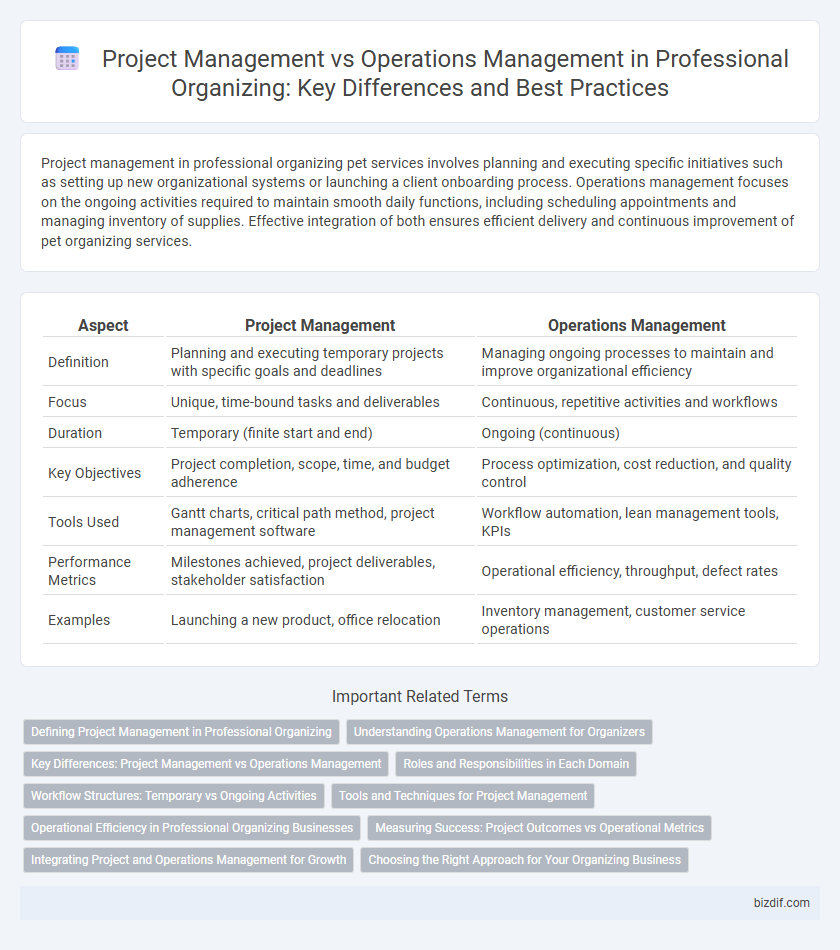Project management in professional organizing pet services involves planning and executing specific initiatives such as setting up new organizational systems or launching a client onboarding process. Operations management focuses on the ongoing activities required to maintain smooth daily functions, including scheduling appointments and managing inventory of supplies. Effective integration of both ensures efficient delivery and continuous improvement of pet organizing services.
Table of Comparison
| Aspect | Project Management | Operations Management |
|---|---|---|
| Definition | Planning and executing temporary projects with specific goals and deadlines | Managing ongoing processes to maintain and improve organizational efficiency |
| Focus | Unique, time-bound tasks and deliverables | Continuous, repetitive activities and workflows |
| Duration | Temporary (finite start and end) | Ongoing (continuous) |
| Key Objectives | Project completion, scope, time, and budget adherence | Process optimization, cost reduction, and quality control |
| Tools Used | Gantt charts, critical path method, project management software | Workflow automation, lean management tools, KPIs |
| Performance Metrics | Milestones achieved, project deliverables, stakeholder satisfaction | Operational efficiency, throughput, defect rates |
| Examples | Launching a new product, office relocation | Inventory management, customer service operations |
Defining Project Management in Professional Organizing
Project management in professional organizing involves planning, executing, and closing specific organizing assignments with defined goals, timelines, and deliverables. It emphasizes resource allocation, task coordination, and progress tracking to achieve client objectives efficiently. Unlike operations management, project management centers on temporary, unique initiatives rather than ongoing processes.
Understanding Operations Management for Organizers
Operations management for professional organizers involves streamlining workflows, resource allocation, and process optimization to enhance efficiency in organizing projects. It focuses on the day-to-day execution of organizing tasks, ensuring consistency, quality control, and client satisfaction. Mastery of operations management enables organizers to balance multiple projects while maintaining high service standards and operational excellence.
Key Differences: Project Management vs Operations Management
Project management involves planning, executing, and closing temporary projects with specific goals, timelines, and budgets, often seen in professional organizing when setting up new systems or spaces. Operations management focuses on overseeing ongoing processes and workflows to maintain efficiency and consistency in daily activities, such as managing routine organization maintenance and upkeep. Key differences include project management's emphasis on unique, finite tasks versus operations management's role in sustaining continuous, repeatable processes.
Roles and Responsibilities in Each Domain
Project management in professional organizing involves defining specific goals, creating timelines, and managing resources to complete unique organizing projects within set deadlines. Operations management focuses on maintaining efficient, ongoing systems, optimizing workflows, and ensuring consistent service quality in day-to-day organizational tasks. Project managers drive one-time initiatives, while operations managers oversee continuous processes to support long-term organizational effectiveness.
Workflow Structures: Temporary vs Ongoing Activities
Project management in professional organizing focuses on temporary, goal-oriented workflow structures designed to complete specific organizing projects within set timelines. Operations management, on the other hand, oversees ongoing activities and continuous processes that maintain and improve organizational systems over time. Efficient workflow design in project management ensures clear milestones and deliverables, whereas operations management emphasizes consistency, resource allocation, and process optimization for sustained organizational efficiency.
Tools and Techniques for Project Management
Project management in professional organizing relies heavily on tools like Gantt charts, Kanban boards, and project management software such as Trello or Asana to plan, schedule, and track tasks effectively. Techniques such as Work Breakdown Structure (WBS) and Critical Path Method (CPM) enable precise allocation of resources and time, ensuring efficient project completion. These project management tools contrast with operations management, which focuses more on process optimization and repeatability rather than discrete task planning.
Operational Efficiency in Professional Organizing Businesses
Operational efficiency in professional organizing businesses hinges on the seamless integration of project management and operations management. Project management drives the completion of specific organizing assignments with defined timelines and goals, while operations management focuses on streamlining everyday processes such as client intake, scheduling, and inventory control. Optimizing these functions enhances resource allocation, reduces downtime, and improves client satisfaction by ensuring consistent, high-quality service delivery.
Measuring Success: Project Outcomes vs Operational Metrics
Project management success is measured by achieving specific outcomes within defined scope, time, and budget constraints, emphasizing milestones and deliverables. Operational management focuses on ongoing performance metrics such as efficiency, productivity, cost control, and customer satisfaction to ensure continuous improvement. In professional organizing, balancing project outcomes with operational metrics drives sustained organizational effectiveness and client satisfaction.
Integrating Project and Operations Management for Growth
Integrating project management and operations management drives professional organizing firms toward scalable growth by aligning strategic initiatives with daily processes. Project management focuses on temporary, goal-specific tasks such as client relocations, while operations management ensures consistent efficiency in ongoing services like space optimization and inventory systems. Leveraging both disciplines enhances resource allocation, streamlines workflows, and maximizes overall organizational performance.
Choosing the Right Approach for Your Organizing Business
Project management in professional organizing focuses on planning and executing specific client projects with clear timelines and goals, while operations management emphasizes the ongoing efficiency and workflow of the organizing business itself. Choosing the right approach depends on whether the priority is delivering tailored, time-bound organizing solutions or optimizing daily processes and resource allocation for long-term success. Aligning strategy with business needs maximizes client satisfaction and operational productivity in the organizing industry.
project management vs operations management Infographic

 bizdif.com
bizdif.com